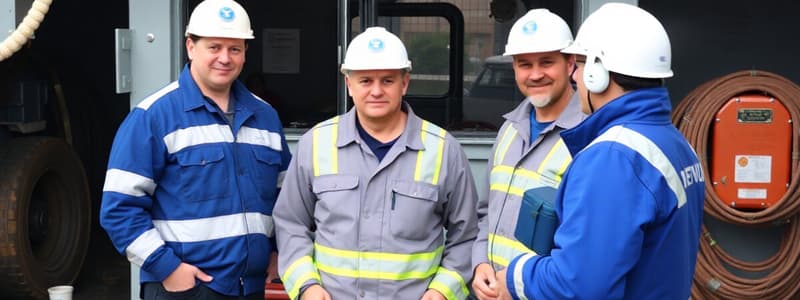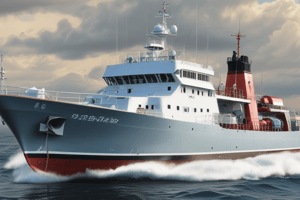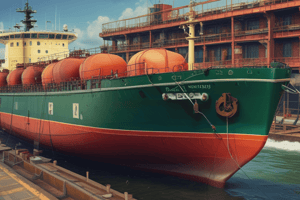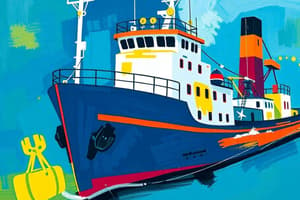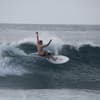Podcast
Questions and Answers
With reference to the SOLAS requirements for conducting regular emergency musters and drills: state the accepted emergency signal for calling crew and passengers to lifeboat muster stations.
With reference to the SOLAS requirements for conducting regular emergency musters and drills: state the accepted emergency signal for calling crew and passengers to lifeboat muster stations.
Seven or more short blasts followed by one long blast on the ship's whistle and internal alarm bells.
With reference to the SOLAS requirements for conducting regular emergency musters and drills: state when emergency drills must be carried out.
With reference to the SOLAS requirements for conducting regular emergency musters and drills: state when emergency drills must be carried out.
Emergency drills (abandon ship and fire) must be conducted weekly. If more than 25% of the crew has not participated in abandon ship and fire drills on board that particular ship in the previous month, drills should be held within 24 hours of leaving a port. Additionally, a muster of newly embarked passengers should take place prior to or immediately upon departure.
With reference to the SOLAS requirements for conducting regular emergency musters and drills: list FOUR types of emergency drill that must be conducted on a regular basis.
With reference to the SOLAS requirements for conducting regular emergency musters and drills: list FOUR types of emergency drill that must be conducted on a regular basis.
- Abandon ship drill
- Fire drill
- Enclosed space entry and rescue drill
- Damage control drill (where applicable)
List FIVE statutory items that the relieving officer shall be informed of by the officer in charge of the engineering watch prior to taking over the engineering watch.
List FIVE statutory items that the relieving officer shall be informed of by the officer in charge of the engineering watch prior to taking over the engineering watch.
With reference to Oily Water Separators and the pumping of bilges: state the limit on oil discharge.
With reference to Oily Water Separators and the pumping of bilges: state the limit on oil discharge.
With reference to Oily Water Separators and the pumping of bilges: list FOUR items which must be recorded in the Oil Record Book when bilges are pumped overboard using a non-automatic system.
With reference to Oily Water Separators and the pumping of bilges: list FOUR items which must be recorded in the Oil Record Book when bilges are pumped overboard using a non-automatic system.
With reference to Oily Water Separators and the pumping of bilges: state what should happen if the content of the oil in the discharge overboard is detected as exceeding the limit set using an automatic system.
With reference to Oily Water Separators and the pumping of bilges: state what should happen if the content of the oil in the discharge overboard is detected as exceeding the limit set using an automatic system.
With reference to Oily Water Separators and the pumping of bilges: list THREE conditions/faults which interfere with oil water separation.
With reference to Oily Water Separators and the pumping of bilges: list THREE conditions/faults which interfere with oil water separation.
With reference to the bunkering and storage of marine diesel fuel: state the meaning of the term closed flash point.
With reference to the bunkering and storage of marine diesel fuel: state the meaning of the term closed flash point.
With reference to the bunkering and storage of marine diesel fuel: state the maximum temperature at which diesel fuel oil can be stored.
With reference to the bunkering and storage of marine diesel fuel: state the maximum temperature at which diesel fuel oil can be stored.
With reference to the bunkering and storage of marine diesel fuel: explain why a representative sample of the fuel should be obtained.
With reference to the bunkering and storage of marine diesel fuel: explain why a representative sample of the fuel should be obtained.
With reference to the bunkering and storage of marine diesel fuel: state how long a fuel oil sample should be retained on board.
With reference to the bunkering and storage of marine diesel fuel: state how long a fuel oil sample should be retained on board.
With reference to the bunkering and storage of marine diesel fuel: state TWO tests which should be carried out on a sample of fuel before commencing bunkers.
With reference to the bunkering and storage of marine diesel fuel: state TWO tests which should be carried out on a sample of fuel before commencing bunkers.
With reference to Sewage Treatment Plants: state the time interval between inspections.
With reference to Sewage Treatment Plants: state the time interval between inspections.
With reference to Sewage Treatment Plants: describe the procedure involved in the inspection in part (a).
With reference to Sewage Treatment Plants: describe the procedure involved in the inspection in part (a).
With reference to Sewage Treatment Plants: explain the reason for fitting a flame gauze to a sewage treatment plant, stating where it would be found.
With reference to Sewage Treatment Plants: explain the reason for fitting a flame gauze to a sewage treatment plant, stating where it would be found.
With reference to refrigeration plants, describe the effects of undercharge of refrigerant, stating remedial actions to be taken.
With reference to refrigeration plants, describe the effects of undercharge of refrigerant, stating remedial actions to be taken.
With reference to refrigeration plants, describe the effects of air in the system, stating remedial actions to be taken.
With reference to refrigeration plants, describe the effects of air in the system, stating remedial actions to be taken.
With reference to refrigeration plants, describe the effects of water or moisture in the system, stating remedial actions to be taken.
With reference to refrigeration plants, describe the effects of water or moisture in the system, stating remedial actions to be taken.
With reference to fresh water production: describe the term Reverse Osmosis.
With reference to fresh water production: describe the term Reverse Osmosis.
Describe, with the aid of a sketch, the construction and operation of an Active Controlled Tank roll damping system.
Describe, with the aid of a sketch, the construction and operation of an Active Controlled Tank roll damping system.
With reference to portable fire extinguishers: describe the examination and testing of portable fire extinguishers as specified in the UK and International legislation.
With reference to portable fire extinguishers: describe the examination and testing of portable fire extinguishers as specified in the UK and International legislation.
With reference to portable fire extinguishers: state the classes of fire that Dry powder extinguishers may be safely used.
With reference to portable fire extinguishers: state the classes of fire that Dry powder extinguishers may be safely used.
With reference to portable fire extinguishers: describe the operation of a portable CO₂ fire extinguisher.
With reference to portable fire extinguishers: describe the operation of a portable CO₂ fire extinguisher.
With reference to a vessel's structure, explain the meaning of beam.
With reference to a vessel's structure, explain the meaning of beam.
With reference to a vessel's structure, explain the meaning of girder.
With reference to a vessel's structure, explain the meaning of girder.
Flashcards
Emergency signal for lifeboat muster stations
Emergency signal for lifeboat muster stations
An emergency signal to call crew and passengers to lifeboat muster stations.
Closed Flash Point
Closed Flash Point
The lowest temperature at which the vapor of a combustible liquid will momentarily ignite in air when exposed to an open flame.
Representative Fuel Sample
Representative Fuel Sample
Ensures the fuel is representative of the entire batch and tests are reflective of all the fuel being bunkered.
Reverse Osmosis
Reverse Osmosis
Signup and view all the flashcards
Beam (Vessel Structure)
Beam (Vessel Structure)
Signup and view all the flashcards
Frame (Vessel Structure)
Frame (Vessel Structure)
Signup and view all the flashcards
Girder (Vessel Structure)
Girder (Vessel Structure)
Signup and view all the flashcards
Beam Knee (Vessel Structure)
Beam Knee (Vessel Structure)
Signup and view all the flashcards
Stringer (Vessel Structure)
Stringer (Vessel Structure)
Signup and view all the flashcards
Study Notes
- The Certificate of Competency Examination is administered by the Scottish Qualifications Authority (SQA) on behalf of the Maritime and Coastguard Agency
- The exam is for Small Vessel EOOW
- The exam code is 060-02
- The exam covers Operational Procedures, Basic Hotel Services, and Ship Construction
- The exam is on Friday, 27 October 2023, from 1400-1600 hrs
- The examination is worth 100 marks
- The pass mark is 50 marks
- Non-programmable calculators may be used during the exam
- All formulae used must be stated clearly
- The method of working and all intermediate steps must be clear in the answer
- Candidates will need their examination workbook
Emergency Drills and SOLAS Requirements
- State the accepted emergency signal for calling crew and passengers to lifeboat muster stations (2 marks)
- State when emergency drills must be carried out (4 marks)
- List four types of emergency drill that must be conducted on a regular basis (4 marks)
Engineering Watch Handover
- List 5 statutory items that the relieving officer must be informed of, by the officer in charge of the engineering watch prior to taking over the watch (10 marks)
Oily Water Separators and Bilge Pumping
- State the limit on oil discharge (1 mark)
- List four items to record in the Oil Record Book when bilges are pumped overboard using a non-automatic system (2 marks)
- State what happens if the oil content in overboard discharge exceeds the limit using an automatic system (4 marks)
- List three conditions or faults that interfere with oil-water separation (3 marks)
Marine Diesel Fuel Bunkering and Storage
- State the meaning of "closed flash point" (3 marks)
- State the maximum storage temperature for diesel fuel oil (1 mark)
- Explain why obtaining a representative fuel sample is important (3 marks)
- State how long to retain a fuel oil sample on board (1 mark)
- State two tests to perform on a fuel sample before commencing bunkers (2 marks)
Sewage Treatment Plants
- State the time interval between inspections (1 mark)
- Describe the inspection procedure (6 marks)
- Explain the reason for fitting a flame gauze to a sewage treatment plant and where it's located (3 marks)
Refrigeration Plants
- Describe the effects of an undercharge of refrigerant and the remedial actions (3 marks)
- Describe the effects of air in the system and the remedial actions (3 marks)
- Describe the effects of water or moisture in the system and the remedial actions (4 marks)
Fresh Water Production
- Describe the term "Reverse Osmosis" (3 marks)
- Sketch a Reverse Osmosis system, labeling all components (7 marks)
Active Controlled Tank Roll Damping System
- Describe, with the aid of a sketch, the construction and operation of an Active Controlled Tank roll damping system (10 marks)
Portable Fire Extinguishers
- Describe the examination and testing of portable fire extinguishers as per the UK and International legislation (6 marks)
- State the classes of fire on which dry powder extinguishers may be safely used (2 marks)
- Describe the operation of a portable CO₂ fire extinguisher (2 marks)
Vessel Structure
- Explain the meaning of "beam" (2 marks)
- Explain the meaning of "frame" (2 marks)
- Explain the meaning of "girder" (2 marks)
- Explain the meaning of "beam knee" (2 marks)
- Explain the meaning of "stringer" (2 marks)
Studying That Suits You
Use AI to generate personalized quizzes and flashcards to suit your learning preferences.
